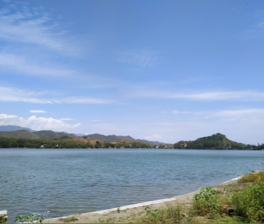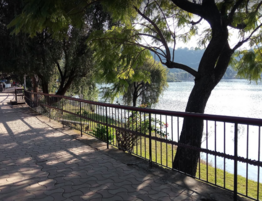| Mansar Lake | |
|---|---|
 Mansar Lake Mansar Lake | |
 | |
| Location | Jammu and Kashmir |
| Coordinates | 32°41′46″N 75°08′48″E / 32.6961°N 75.1468°E / 32.6961; 75.1468 |
| Basin countries | India |
| Max. width | 645 metres (2,116 ft) |
| Surface area | 590,000 m (6,400,000 sq ft) |
| Average depth | 38 metres (125 ft) |
| Max. depth | 38.25 metres (125.5 ft) |
| Water volume | 12.37 million cubic metres (437×10 |
| Ramsar Wetland | |
| Official name | Surinsar-Mansar Lakes |
| Designated | 8 November 2005 |
| Reference no. | 1573 |
Mansar Lake is a lake located 62 km (39 mi) from the city of Jammu in Jammu and Kashmir, India. It is fringed by forest-covered hills, and is over a mile (1.6 km) in length and half-a-mile (0.80 km) in width. Surinsar-Mansar Lakes are designated as Ramsar Convention sites in November 2005. Mansar is primarily fed by surface run-off and partially by mineralised water through paddy fields. The lake supports CITES and IUCN redlisted Lissemys punctuata, Aspideretes gangeticus and Mansariella lacustris. The composite lake is high in micro nutrients for which it is an attractive habitat, breeding and nursery ground for migratory waterfolks like Fulica atra, Gallinula chloropus, Podiceps nigricollis, Aythya fuligula and various Anas species.
About
Besides being a popular excursion destination in Jammu, it is also a holy site, sharing the legend and sanctity of Lake Manasarovar. On the Eastern Bank of the Lake there is a shrine to Shesha (the serpent-mount of Vishnu). The shrine comprises a big boulder on which are placed a number of iron chains perhaps representing the small serpents waiting on the tutelary deity of Shesha. Two ancient temples of Shiva, Narasimha, as well as a temple of Durga are situated in the vicinity of the Mansar lake. People take a holy dip in the water of the lake on festive occasions.
Newlyweds consider it auspicious to perform three circumambulations (parikrama) around the lake to seek the blessings of Shesha, the lord of serpents, whose shrine is located on its eastern bank.
Certain communities of Hindus perform the mundana ceremony (First hair cut) of their male children here.
There are also some ancient temples on the lake's shores, which are visited by devotees in large numbers. Mansar is also ideal for boating for which the Tourism Department provides adequate facilities.
This Mansar lake road joins to another important road that directly links Pathankot (Punjab) to Udhampur (Jammu & Kashmir, Jammu Province. Udhampur is a Town of strategic importance, again on National Highway No. 1A. The shortcut road from Mansar or Samba to Udhampur by-passes the Jammu town. Surinsar Lake, a smaller lake that is linked to Mansar, is 24 km (15 mi) from Jammu (via a bypass road).
Flora and fauna
Areas around Mansar lake are rich in forests. Many types of trees such as Scrub, Peepal and Acacia are found here. The lake is bordered with Pine trees and provides shelter to a number of birds and animals. There is also a wildlife sentury near the lake which provides home to a number of Birds and Animals such as Spotted Deer, Nilgai, Cranes and Ducks. Many types of Fishes and Tortoises are also found in the Lake. Some types of Snakes are also found in the lake.
Legend
According to local tradition based on the Mahabharata, Babruvahana, the son of Arjuna and Ulupi, was the ruler of this area during that time. After the war, Arjuna performed a ritual called the ashvamedha yajna to prove his mettle and vantage over the land. Babruvahana captured the horse which was the power symbol of the yajna at Khoon village near Dhar Udhampur road where later on Babruvahana killed Arjuna. After the victory, Babruvahana shared his success with his mother by presenting the head of Arjuna to her. After knowing that Arjuna was his father, Babruvahana wanted to get Arjuna back. Therefore, he had to procure Mani from Shesha. For that, Babruvahana made a tunnel with his arrow which was known as Surangsar. After defeating Shesha and capturing the mani, he came out of Manisar (Mansar), that was the other end of the tunnel.
Gallery
References
- "Search | J & K SDI" (PDF). Archived (PDF) from the original on 28 January 2023. Retrieved 12 March 2024.
- "Surinsar-Mansar Lakes". Ramsar Sites Information Service. Retrieved 25 April 2018.
- "Department of Tourism, Jammu and Kashmir - Mansar". Archived from the original on 15 July 2017. Retrieved 21 October 2016.
- "Department of Tourism, Jammu and Kashmir - Mansar Lake". Archived from the original on 15 July 2017. Retrieved 21 October 2016.
- "Archived copy" (PDF). Archived from the original (PDF) on 15 July 2021. Retrieved 15 July 2021.
{{cite web}}: CS1 maint: archived copy as title (link) - "Info on Mansar Lake of Jammu | Best Time to Visit | J & K Tourism".
- https://www.jktdc.co.in/Mansar-Lake.aspx
| Hydrography of Jammu and Kashmir | |
|---|---|
| Rivers | |
| Lakes | |
| Glaciers | |
| Dams, barrages | |



